Apache Shiro? is a powerful and easy-to-use Java security framework that performs authentication, authorization, cryptography, and session management. With Shiro’s easy-to-understand API, you can quickly and easily secure any application – from the smallest mobile applications to the largest web and enterprise applications.
Shiro 是一个功能强大且易于使用的Java安全框架,它执行身份验证、授权、加密和会话管理。使用Shiro易于理解的API,您可以快速轻松地保护任何应用程序—从最小的移动应用程序到最大的web和企业应用程序。
Shiro是apache旗下一个开源框架,它将软件系统的安全认证相关的功能抽取出来,实现用户身份认证,权限授权、加密、会话管理等功能,组成了一个通用的安全认证框架。
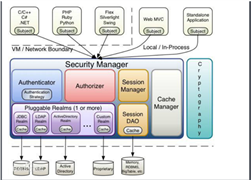

认证的开发
<dependency>
<groupId>org.apache.shiro</groupId>
<artifactId>shiro-core</artifactId>
<version>1.5.3</version>
</dependency>
shiro的配置文件是以.ini结尾的文件,.ini里面可以写一些比较复杂的数据格式,shiro在解析的时候,也是可以直接解析以.ini结尾的配置文件,只要放在resources文件夹下即可,文件名任意,文件格式必须是.ini文件,使用springboot之后,就可以不适用这个配置文件,这个文件主要是用来我们在学习阶段时,书写我们shiro中相关权限数据,就可以不用连接数据库,直接把权限的数据写死到ini文件中
[users]
xiaochen=123
zhangsan=456
public class TestAuthenticator {
public static void main(String[] args) {
//1.创建安全管理器对象
DefaultSecurityManager securityManager = new DefaultSecurityManager();
//2.给安全管理器设置realm(拿到ini文件中的数据)
securityManager.setRealm(new IniRealm("classpath:shiro.ini"));
//3.SerurityUtils 给全局的安全工具类设置安全管理器
SecurityUtils.setSecurityManager(securityManager);
//4.关键对象 subject代表主体
Subject subject = SecurityUtils.getSubject();
//5.创建令牌
UsernamePasswordToken token = new UsernamePasswordToken("xiaochen","1234");
try{
System.out.println("认证状态:"+subject.isAuthenticated());
subject.login(token);//用户认证
System.out.println("认证状态:"+subject.isAuthenticated());
}catch (UnknownAccountException e){
e.printStackTrace();
System.out.println("认证失败,用户名不存在");
}catch (IncorrectCredentialsException e){
e.printStackTrace();
System.out.println("认证失败,密码错误");
}
}
}
shiro的异常
4.自定义Realm
上边的程序使用的是Shiro自带的IniRealm,IniRealm从ini配置文件中读取用户的信息,大部分情况下需要从系统的数据库中读取用户信息,所以需要自定义realm。
shiro提供的Realm
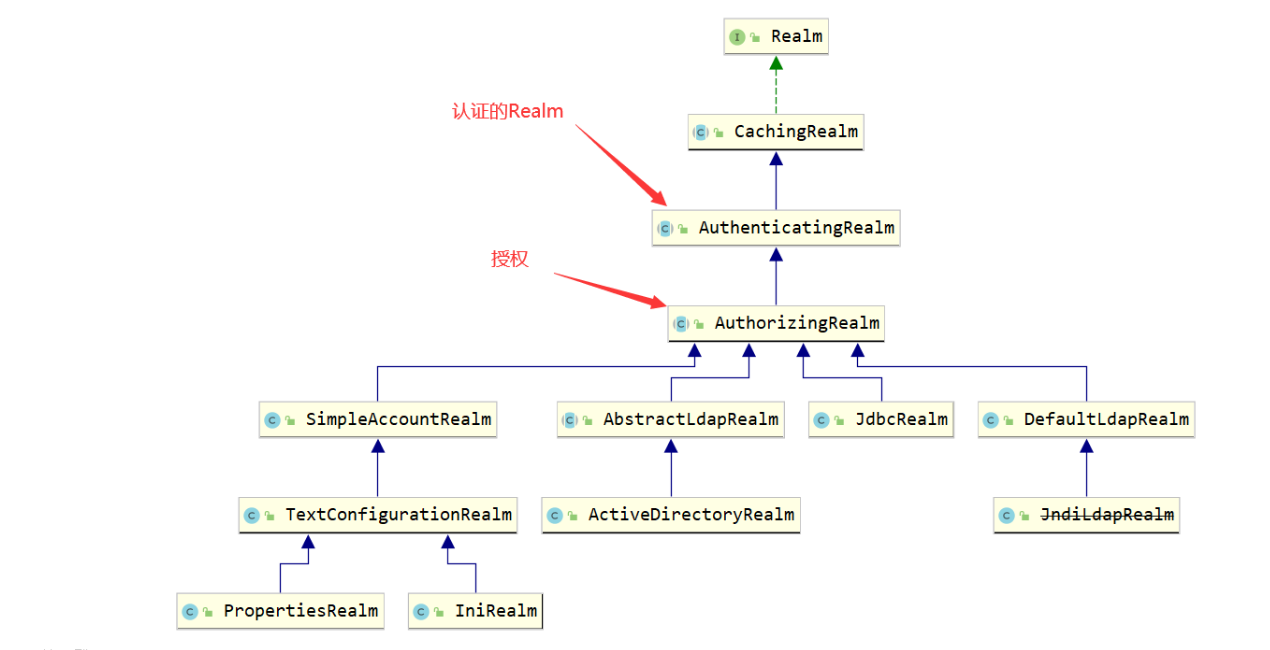
根据认证源码认证使用的是SimpleAccountRealm
SimpleAccountRealm的部分源码中有两个方法一个是 认证 一个是 授权,
public class SimpleAccountRealm extends AuthorizingRealm {
//.......省略
protected AuthenticationInfo doGetAuthenticationInfo(AuthenticationToken token) throws AuthenticationException {
UsernamePasswordToken upToken = (UsernamePasswordToken) token;
SimpleAccount account = getUser(upToken.getUsername());
if (account != null) {
if (account.isLocked()) {
throw new LockedAccountException("Account [" + account + "] is locked.");
}
if (account.isCredentialsExpired()) {
String msg = "The credentials for account [" + account + "] are expired";
throw new ExpiredCredentialsException(msg);
}
}
return account;
}
protected AuthorizationInfo doGetAuthorizationInfo(PrincipalCollection principals) {
String username = getUsername(principals);
USERS_LOCK.readLock().lock();
try {
return this.users.get(username);
} finally {
USERS_LOCK.readLock().unlock();
}
}
}
/**
* @Author CDL
* @Date 2020/12/18 14:54
* @Desc 自定义realm实现,将认证/授权数据的来源转为数据库的实现
* @Version 1.0.
*/
public class CustomerRealm extends AuthorizingRealm {
//授权
@Override
protected AuthorizationInfo doGetAuthorizationInfo(PrincipalCollection principals) {
return null;
}
//认证
@Override
protected AuthenticationInfo doGetAuthenticationInfo(AuthenticationToken token) throws AuthenticationException {
//在token中获取用户名
String principal = token.getPrincipal().toString();
//根据身份信息查询数据库进行验证,这里使用假数据,模拟数据库
if("xiaochen".equals(principal)){
//参数1:返回数据库中正确的用户名,参数2:返回数据库中的正确密码 参数3:提供当前父类的realm的名字,直接使用this.getName()
// simpleAuthenticationInfo 相当于数据库中拿到的数据
SimpleAuthenticationInfo simpleAuthenticationInfo = new SimpleAuthenticationInfo("xiaochen","123",this.getName());
return simpleAuthenticationInfo;
}
return null;
}
}
/**
* @Author CDL
* @Date 2020/12/18 14:58
* @Desc 使用自定义realm,进行认证
* @Version 1.0.
*/
public class TestCustomerRealmAuthenticator {
public static void main(String[] args) {
//创建securityManager
DefaultSecurityManager defaultSecurityManager = new DefaultSecurityManager();
//设置之定义realm
defaultSecurityManager.setRealm(new CustomerRealm());
//将安全工具类设置安全管理器
SecurityUtils.setSecurityManager(defaultSecurityManager);
//通过安全工具类获取subject
Subject subject = SecurityUtils.getSubject();
//创建token,这里的用户名密码就相当于浏览器的登录数据,把这个数据放到token,再去与使用数据库的数据进行认证
UsernamePasswordToken token = new UsernamePasswordToken("xiaochen", "123");
try {
subject.login(token);
} catch (UnknownAccountException e){
e.printStackTrace();
System.out.println("认证失败,用户名不存在");
}catch (IncorrectCredentialsException e){
e.printStackTrace();
System.out.println("认证失败,密码错误");
}
}
}
使用MD5和Salt
实际应用是将盐和散列后的值存在数据库中,自动realm从数据库取出盐和加密后的值由shiro完成密码校验。
/**
* 自定义md5+salt realm
*/
public class CustomerRealm extends AuthorizingRealm {
//认证方法
@Override
protected AuthorizationInfo doGetAuthorizationInfo(PrincipalCollection principals) {
return null;
}
//授权方法
@Override
protected AuthenticationInfo doGetAuthenticationInfo(AuthenticationToken token) throws AuthenticationException {
String principal = (String) token.getPrincipal();
if("xiaochen".equals(principal)){
String password = "3c88b338102c1a343bcb88cd3878758e";
String salt = "Q4F%";
return new SimpleAuthenticationInfo(principal,password,
ByteSource.Util.bytes(salt),this.getName());
}
return null;
}
MD5还可以用来校验两个文件是否相同,生成的结构始终是16进制,长度为32位的字符串
测试MD5加密
public class TestShiroMD5 {
public static void main(String[] args) {
//使用MD5
Md5Hash md5Hash = new Md5Hash("123");
System.out.println(md5Hash.toHex());
//使用MD5 + salt 处理,默认把盐加在后面 salt做一个随机字符串即可,这里随意写一个
Md5Hash md5Hash1 = new Md5Hash("123", "X08*PWQD");
System.out.println(md5Hash1.toHex());
//使用MD5 + salt + hash 散列 第三个参数表示散列的次数
Md5Hash md5Hash2 = new Md5Hash("123", "X08*PWQD", 1024);
System.out.println(md5Hash2.toHex());
}
}
/**
202cb962ac59075b964b07152d234b70
67005b4f11230614c9150f6843425f79
78f4452361e7c07ef9cd3d1fcbd5f629
*/
自定义md5+salt的realm
/**
* @Author CDL
* @Date 2020/12/18 16:48
* @Desc 使用自定义realm加入md5,随机盐,
* @Version 1.0.
*/
public class CustomerMd5Realm extends AuthorizingRealm {
@Override
protected AuthorizationInfo doGetAuthorizationInfo(PrincipalCollection principals) {
return null;
}
@Override
protected AuthenticationInfo doGetAuthenticationInfo(AuthenticationToken token) throws AuthenticationException {
//获取身份信息
String principal = token.getPrincipal().toString();
//根据用户名查询数据库
if("xiaochen".equals(principal)){
/**
* 参数1:数据库的用户名
* 参数1:数据库MD5+salt之后的密码
* 参数1:注册时数据库的随即盐
* 参数1:realm的名字
*/
return new SimpleAuthenticationInfo(principal,"78f4452361e7c07ef9cd3d1fcbd5f629",
ByteSource.Util.bytes("X08*PWQD"),this.getName());
}
return null;
}
}
改造shiro的认证流程,加入MD5和随机盐的处理
/**
* @Author CDL
* @Date 2020/12/18 16:50
* @Desc 使用md5 + salt 认证
* @Version 1.0.
*/
public class TestCustomerMd5RealmAuthenticator {
public static void main(String[] args) {
//创建安全管理器
DefaultSecurityManager defaultSecurityManager = new DefaultSecurityManager();
//注入realm
CustomerMd5Realm realm = new CustomerMd5Realm();
//设置realm使用hash凭证匹配器
HashedCredentialsMatcher hashedCredentialsMatcher = new HashedCredentialsMatcher();
hashedCredentialsMatcher.setHashAlgorithmName("md5");
//设置散列次数
hashedCredentialsMatcher.setHashIterations(1024);
realm.setCredentialsMatcher(hashedCredentialsMatcher);
defaultSecurityManager.setRealm(realm);
//将安全管理器注入安全工具列
SecurityUtils.setSecurityManager(defaultSecurityManager);
//通过安全工具类获取subjiect
Subject subject = SecurityUtils.getSubject();
//认证
UsernamePasswordToken token = new UsernamePasswordToken("xiaochen", "123");
try {
subject.login(token);
System.out.println("登录成功");
} catch (UnknownAccountException e){
e.printStackTrace();
System.out.println("认证失败,用户名不存在");
}catch (IncorrectCredentialsException e){
e.printStackTrace();
System.out.println("认证失败,密码错误");
}
}
}
授权
关键对象
授权流程
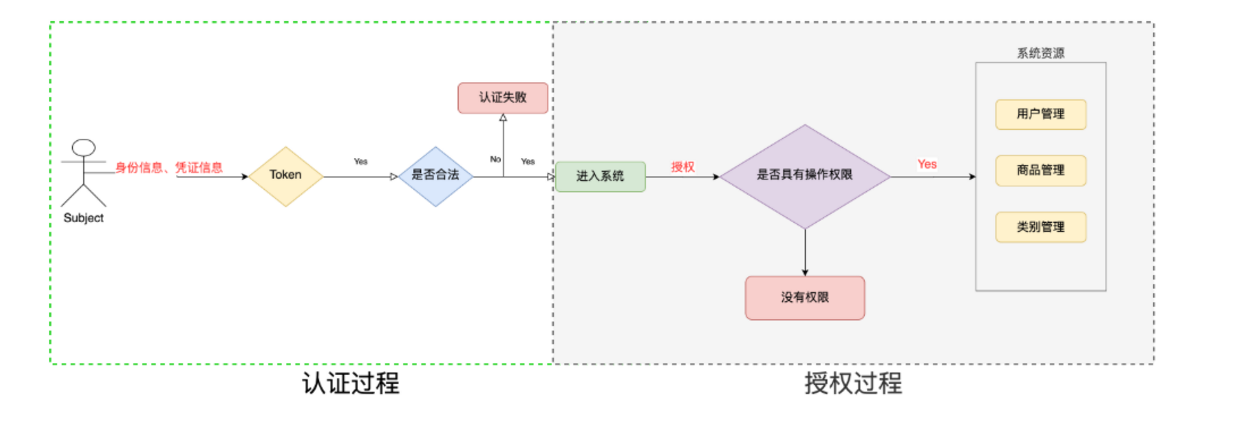
授权方式
权限字符串
例子:
shiro中授权编程实现方式
Subject subject = SecurityUtils.getSubject();
if(subject.hasRole(“admin”)) {
//有权限
} else {
//无权限
}
@RequiresRoles("admin")
public void hello() {
//有权限
}
JSP/GSP 标签:在JSP/GSP 页面通过相应的标签完成:
<shiro:hasRole name="admin">
<!— 有权限—>
</shiro:hasRole>
注意: Thymeleaf 中使用shiro需要额外集成!
开发授权
1.realm的实现
/**
* @Author CDL
* @Date 2020/12/18 16:48
* @Desc 使用自定义realm加入md5,随机盐,
* @Version 1.0.
*/
public class CustomerMd5Realm extends AuthorizingRealm {
@Override
protected AuthorizationInfo doGetAuthorizationInfo(PrincipalCollection principals) {
String primaryPrincipal = principals.getPrimaryPrincipal().toString();
System.out.println("身份信息(用户名)"+primaryPrincipal);
//根据用户名查询数据库的角色信息以及权限信息 假色 xiaochen admin user
SimpleAuthorizationInfo simpleAuthorizationInfo = new SimpleAuthorizationInfo();
//将数据查询的角色信息赋值给权限对象 simpleAuthorizationInfo
simpleAuthorizationInfo.addRole("admin");
simpleAuthorizationInfo.addRole("user");
//将数据库中的查询的权限信息赋值给权限对象
simpleAuthorizationInfo.addStringPermission("user:*:01");
simpleAuthorizationInfo.addStringPermission("product:create:01");
return simpleAuthorizationInfo;
}
@Override
protected AuthenticationInfo doGetAuthenticationInfo(AuthenticationToken token) throws AuthenticationException {
//获取身份信息
String principal = token.getPrincipal().toString();
//根据用户名查询数据库
if("xiaochen".equals(principal)){
/**
* 参数1:数据库的用户名
* 参数1:数据库MD5+salt之后的密码
* 参数1:注册时数据库的随即盐
* 参数1:realm的名字
*/
return new SimpleAuthenticationInfo(principal,"78f4452361e7c07ef9cd3d1fcbd5f629",
ByteSource.Util.bytes("X08*PWQD"),this.getName());
}
return null;
}
}
2.授权
/**
* @Author CDL
* @Date 2020/12/18 16:50
* @Desc 使用md5 + salt 认证
* @Version 1.0.
*/
public class TestCustomerMd5RealmAuthenticator {
public static void main(String[] args) {
//创建安全管理器
DefaultSecurityManager defaultSecurityManager = new DefaultSecurityManager();
//注入realm
CustomerMd5Realm realm = new CustomerMd5Realm();
//设置realm使用hash凭证匹配器
HashedCredentialsMatcher hashedCredentialsMatcher = new HashedCredentialsMatcher();
hashedCredentialsMatcher.setHashAlgorithmName("md5");
//设置散列次数
hashedCredentialsMatcher.setHashIterations(1024);
realm.setCredentialsMatcher(hashedCredentialsMatcher);
defaultSecurityManager.setRealm(realm);
//将安全管理器注入安全工具列
SecurityUtils.setSecurityManager(defaultSecurityManager);
//通过安全工具类获取subjiect
Subject subject = SecurityUtils.getSubject();
//认证
UsernamePasswordToken token = new UsernamePasswordToken("xiaochen", "123");
try {
subject.login(token);
System.out.println("登录成功");
} catch (UnknownAccountException e){
e.printStackTrace();
System.out.println("认证失败,用户名不存在");
}catch (IncorrectCredentialsException e){
e.printStackTrace();
System.out.println("认证失败,密码错误");
}
//认证通过的用户进行授权
if(subject.isAuthenticated()){
//1.基于角色的权限控制
boolean admin = subject.hasRole("admin");
System.out.println(admin);
//2.基于多角色的权限控制 假如一个用户需要同时有两个权限才能访问
boolean b = subject.hasAllRoles(Arrays.asList("user", "admin"));
System.out.println(b);
//3.是否有其中一个角色
boolean[] booleans = subject.hasRoles(Arrays.asList("user", "admin", "super"));
for (boolean aBoolean : booleans) {
System.out.println(aBoolean);
}
//基于权限字符串的访问控制 资源标识符:操作:资源类型
boolean permitted = subject.isPermitted("user:*:*");//是否具有所有user模块的所有权限
System.out.println(permitted);
//分别具有哪些权限
boolean[] permitted1 = subject.isPermitted("user:*:*", "product:*:*");
for (boolean b1 : permitted1) {
System.out.println(b1);
}
//同时具有哪些权限
boolean permittedAll = subject.isPermittedAll("user:*:*", "product:*:*");
System.out.println(permittedAll);
}
}
}
整合思路
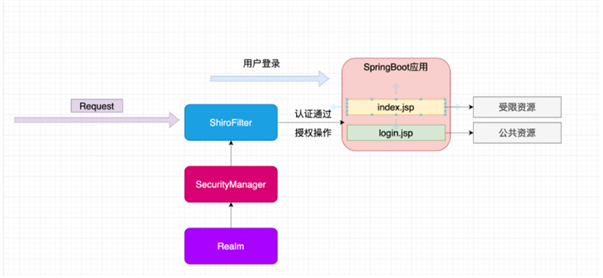
**创建springboot项目 **
1.引入shiro依赖
<dependency>
<groupId>org.apache.shiro</groupId>
<artifactId>shiro-spring-boot-starter</artifactId>
<version>1.5.3</version>
</dependency>
2.配置shiro环境
创建配置类
/**
* date:
* Author:CDL
* desc:用来整合shiro框架相关的配置类
* version:1.0
*/
@Configuration
public class ShiroConfig {
//1.创建shiroFilter 负责拦截请求(所以里面传入一个安全管理器)
@Bean
public ShiroFilterFactoryBean getShiroFilterFactoryBean(DefaultWebSecurityManager defaultWebSecurityManager){
ShiroFilterFactoryBean shiroFilterFactoryBean = new ShiroFilterFactoryBean();
//给Filter设置安全管理器
shiroFilterFactoryBean.setSecurityManager(defaultWebSecurityManager);
//配置系统的受限资源 公共资源
Map<String,String> map = new HashMap<>();
map.put("/index.jsp","authc");
//默认的认证界面的路径
shiroFilterFactoryBean.setLoginUrl("/login.jsp");
shiroFilterFactoryBean.setFilterChainDefinitionMap(map);
return shiroFilterFactoryBean;
}
//2.创建安全管理器 安全管理器里面需要传入数据,所以需要创建Realm
@Bean
public DefaultWebSecurityManager getDefaultWebSecurityManager(Realm realm){
DefaultWebSecurityManager defaultWebSecurityManager = new DefaultWebSecurityManager();
//给安全管理器设置Realm
defaultWebSecurityManager.setRealm(realm);
return defaultWebSecurityManager;
}
//3.创建自定义Realm
@Bean
public Realm getRealm(){
CustomerRealm customerRealm = new CustomerRealm();
return customerRealm;
}
}
自定义Realm
public class CustomerRealm extends AuthorizingRealm {
@Override
protected AuthorizationInfo doGetAuthorizationInfo(PrincipalCollection principalCollection) {
return null;
}
@Override
protected AuthenticationInfo doGetAuthenticationInfo(AuthenticationToken authenticationToken) throws AuthenticationException {
return null;
}
}
启动springboot应用访问index,会发现index被拦截,默认跳转到login.jsp
常见过滤器
| 配置缩写 | 对应的过滤器 | 功能 |
|---|---|---|
| anon | AnonymousFilter | 指定url可以匿名访问 |
| authc | FormAuthenticationFilter | 指定url需要form表单登录,默认会从请求中获取username、password,rememberMe等参数并尝试登录,如果登录不了就会跳转到loginUrl配置的路径。我们也可以用这个过滤器做默认的登录逻辑,但是一般都是我们自己在控制器写登录逻辑的,自己写的话出错返回的信息都可以定制嘛。 |
| authcBasic | BasicHttpAuthenticationFilter | 指定url需要basic登录 |
| logout | LogoutFilter | 登出过滤器,配置指定url就可以实现退出功能,非常方便 |
| noSessionCreation | NoSessionCreationFilter | 禁止创建会话 |
| perms | PermissionsAuthorizationFilter | 需要指定权限才能访问 |
| port | PortFilter | 需要指定端口才能访问 |
| rest | HttpMethodPermissionFilter | 将http请求方法转化成相应的动词来构造一个权限字符串,这个感觉意义不大,有兴趣自己看源码的注释 |
| roles | RolesAuthorizationFilter | 需要指定角色才能访问 |
ssl | SslFilter | 需要https请求才能访问
user | UserFilter | 需要已登录或“记住我”的用户才能访问
<form action="${pageContext.request.contextPath}/user/login" method="post">
用户名:<input type="text" name="username" > <br/>
密码 : <input type="text" name="password"> <br>
<input type="submit" value="登录">
</form>
@RequestMapping("user")
@Controller
public class UserController {
//用户登陆的时候,需要进行安全验证
@RequestMapping("/login")
public String login(String username,String password){
//获取主题对象
Subject subject = SecurityUtils.getSubject();
try {
//把用户名密码封装成token,进行认证
//登录的时候,会调用realm中(数据库)的数据进行比较,所以现在该区realm中进行认证了
subject.login(new UsernamePasswordToken(username,password));
return "redirect:/index.jsp";
} catch (UnknownAccountException e) {
e.printStackTrace();
System.out.println("用户名错误!!");
}catch (IncorrectCredentialsException e){
e.printStackTrace();
System.out.println("密码错误!!!");
}
return "redirect:/login.jsp";
}
}
3.开发realm中返回静态数据(未连接数据库)
public class CustomerRealm extends AuthorizingRealm {
@Override
protected AuthorizationInfo doGetAuthorizationInfo(PrincipalCollection principalCollection) {
return null;
}
@Override
protected AuthenticationInfo doGetAuthenticationInfo(AuthenticationToken token) throws AuthenticationException {
String s = token.getPrincipal().toString();
if("xiaochen".equals(s)){
return new SimpleAuthenticationInfo(s,"123",this.getName());
}
return null;
}
}
4.启动项目以realm中定义静态数据进行认证
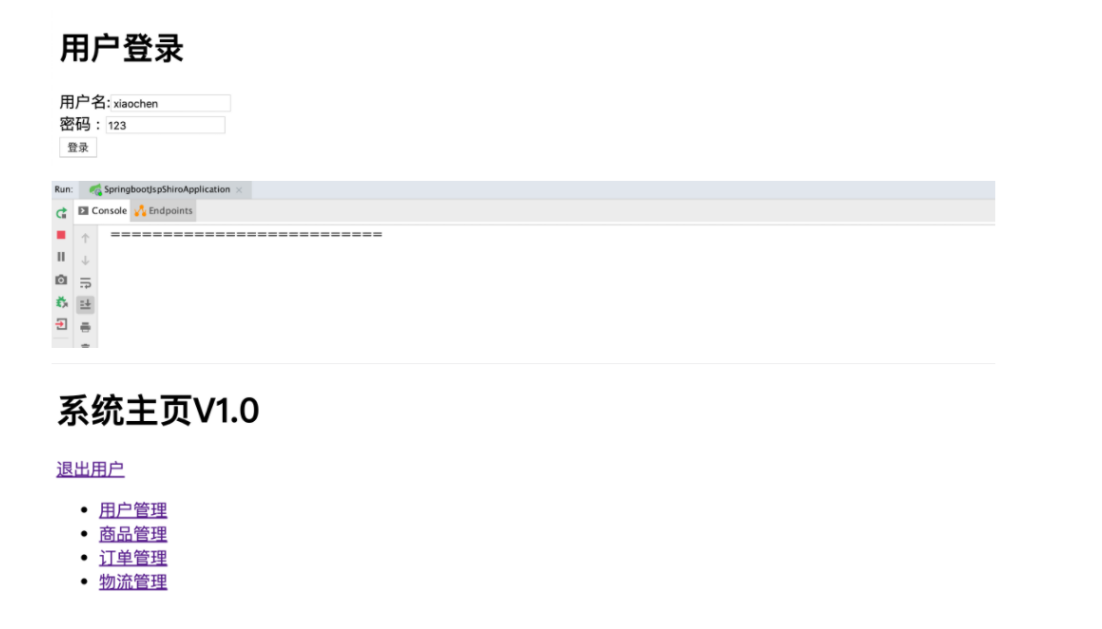
1.开发页面退出连接
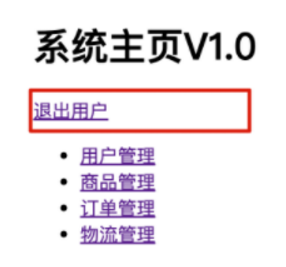
2.开发controller
//退出登录
@RequestMapping("/logout")
public String logout(){
Subject subject = SecurityUtils.getSubject();
subject.logout();
return "redirect:/login.jsp";
}
3.退出之后访问受限资源立即返回认证界面
1.创建数据表结构

0.开发注册界面
<h1>用户注册</h1>
<form action="${pageContext.request.contextPath}/user/register" method="post">
用户名:<input type="text" name="username" > <br/>
密码 : <input type="text" name="password"> <br>
<input type="submit" value="立即注册">
</form>
2.项目引入依赖
<!--mybatis相关依赖-->
<dependency>
<groupId>org.mybatis.spring.boot</groupId>
<artifactId>mybatis-spring-boot-starter</artifactId>
<version>2.1.2</version>
</dependency>
<!--mysql-->
<dependency>
<groupId>mysql</groupId>
<artifactId>mysql-connector-java</artifactId>
<version>5.1.38</version>
</dependency>
<!--druid-->
<dependency>
<groupId>com.alibaba</groupId>
<artifactId>druid</artifactId>
<version>1.1.19</version>
</dependency>
3.配置application.properties配置文件
server.port=8888
# 应用的上下文路径,也可以称为项目路径,是构成url地址的一部分。 就可以直接以;localhost:8888/shiro/index.jsp直接访问
server.servlet.context-path=/shiro
spring.application.name=shiro
# 通过这两个配置把视图换成/和jsp
spring.mvc.view.prefix=/
spring.mvc.view.suffix=.jsp
spring.datasource.type=com.alibaba.druid.pool.DruidDataSource
spring.datasource.driver-class-name=com.mysql.jdbc.Driver
spring.datasource.url=jdbc:mysql://localhost:3306/study?serverTimezone=UTC&useUnicode=true&characterEncoding=utf-8
spring.datasource.username=root
spring.datasource.password=root
mybatis.type-aliases-package=com.cdl.entity
mybatis.mapper-locations=classpath:mapper/*.xml
4.创建entity
@Data
@Accessors(chain = true)
@AllArgsConstructor
@NoArgsConstructor
public class User {
private String id;
private String username;
private String password;
private String salt;
}
5.创建DAO接口
@Mapper
public interface UserDAO {
void save(User user);
}
6.开发mapper配置文件
<!DOCTYPE mapper PUBLIC "-//mybatis.org//DTD Mapper 3.0//EN" "http://mybatis.org/dtd/mybatis-3-mapper.dtd">
<mapper namespace="com.cdl.dao.UserDao">
<insert id="save">
insert into user values (#{id},#{username},#{password},#{salt})
</insert>
</mapper>
7.开发service接口
public interface UserService {
//注册用户方法
void register(User user);
}
8.创建salt工具类
public class SaltUtils {
/**
* 生成salt的静态方法
* @param n
* @return
*/
public static String getSalt(int n){
char[] chars = "ABCDEFGHIJKLMNOPQRSTUVWXYZabcdefghijklmnopqrstuvwxyz01234567890!@#$%^&*()".toCharArray();
StringBuilder sb = new StringBuilder();
for (int i = 0; i < n; i++) {
char aChar = chars[new Random().nextInt(chars.length)];
sb.append(aChar);
}
return sb.toString();
}
}
9.开发service实现类
@Service
@Transactional
public class UserServiceImpl implements UserService {
@Autowired
private UserDAO userDAO;
@Override
public void register(User user) {
//处理业务调用dao
//1.生成随机盐
String salt = SaltUtils.getSalt(8);
//2.将随机盐保存到数据
user.setSalt(salt);
//3.明文密码进行md5 + salt + hash散列
Md5Hash md5Hash = new Md5Hash(user.getPassword(),salt,1024);
user.setPassword(md5Hash.toHex());
userDAO.save(user);
}
}
10.开发Controller
@Controller
@RequestMapping("user")
public class UserController {
@Autowired
private UserService userService;
/**
* 用户注册
*/
@RequestMapping("register")
public String register(User user) {
try {
userService.register(user);
return "redirect:/login.jsp";
}catch (Exception e){
e.printStackTrace();
return "redirect:/register.jsp";
}
}
}
11.启动项目进行注册--成功
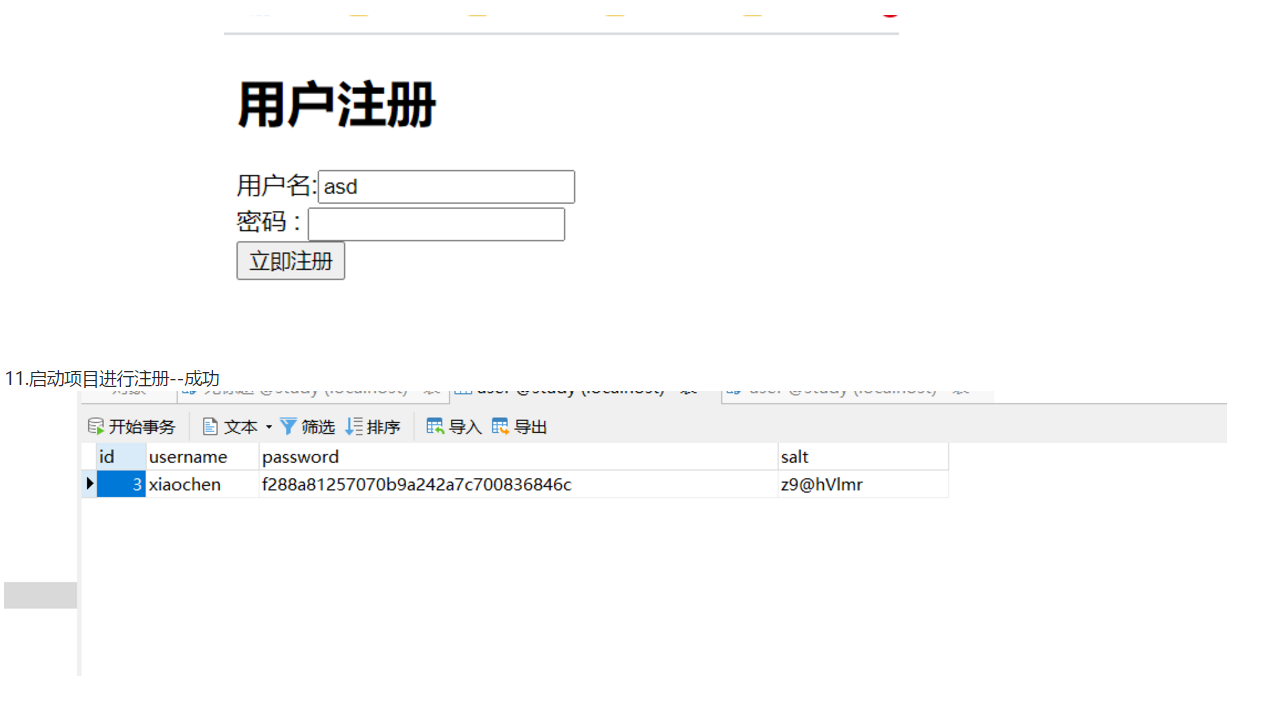
0.开发DAO
@Mapper
public interface UserDAO {
void save(User user);
//根据身份信息认证的方法
User findByUserName(String username);
}
1.开发mapper配置文件
<select id="findByUserName" parameterType="String" resultType="User">
select id,username,password,salt from user
where username = #{username}
</select>
2.开发Service接口
public interface UserService {
//注册用户方法
void register(User user);
//根据用户名查询业务的方法
User findByUserName(String username);
}
3.开发Service实现类
@Service("userService")
@Transactional
public class UserServiceImpl implements UserService {
@Autowired
private UserDAO userDAO;
@Override
public User findByUserName(String username) {
return userDAO.findByUserName(username);
}
}
4.开发在工厂中获取bean对象的工具类
@Component
public class ApplicationContextUtils implements ApplicationContextAware {
private static ApplicationContext context;
@Override
public void setApplicationContext(ApplicationContext applicationContext) throws BeansException {
this.context = applicationContext;
}
//根据bean名字获取工厂中指定bean 对象
public static Object getBean(String beanName){
return context.getBean(beanName);
}
}
5.修改自定义realm
@Override
protected AuthenticationInfo doGetAuthenticationInfo(AuthenticationToken token) throws AuthenticationException {
String s = token.getPrincipal().toString();
//在工厂中获取service对象 因为Realm这个类没有注册到工厂中,所以拿不到工厂中的对象,所以要写一个工具类去拿工厂中的对象
UserService userService = (UserService) ApplicationContextUtils.getBean("userService");
User user = userService.findByUserName(s);
//根据用户名查询密码进行验证
if(!ObjectUtils.isEmpty(user)){
//返回数据库信息
return new SimpleAuthenticationInfo(user.getUsername(),user.getPassword(),
ByteSource.Util.bytes(user.getSalt()),this.getName());
}
return null;
}
6.修改ShiroConfig中realm使用凭证匹配器以及hash散列
@Bean
public Realm getRealm(){
CustomerRealm customerRealm = new CustomerRealm();
//设置hashed凭证匹配器
HashedCredentialsMatcher credentialsMatcher = new HashedCredentialsMatcher();
//设置md5加密
credentialsMatcher.setHashAlgorithmName("md5");
//设置散列次数
credentialsMatcher.setHashIterations(1024);
customerRealm.setCredentialsMatcher(credentialsMatcher);
return customerRealm;
}
实现权限有三种方式,编程式,注解式,标签式(上面有说到),如果什么写,这不会进行权限验证
0.页面资源授权(以标签的形式授权)
<%@page contentType="text/html; UTF-8" pageEncoding="UTF-8" isELIgnored="false" %>
<%@taglib prefix="shiro" uri="http://shiro.apache.org/tags" %>
<!doctype html>
<html lang="en">
<head>
<meta charset="UTF-8">
<meta name="viewport"
content="width=device-width, user-scalable=no, initial-scale=1.0, maximum-scale=1.0, minimum-scale=1.0">
<meta http-equiv="X-UA-Compatible" content="ie=edge">
<title>Document</title>
</head>
<body>
<h1>系统主页v1.0</h1>
<a href="${pageContext.request.contextPath}/user/logout">退出用户</a>
<ul>
<shiro:hasAnyRoles name="user,admin">
<li><a href="">用户管理</a>
<ul>
<shiro:hasPermission name="user:add:*">
<li><a href="">添加</a></li>
</shiro:hasPermission>
<shiro:hasPermission name="user:delete:*">
<li><a href="">删除</a></li>
</shiro:hasPermission>
<shiro:hasPermission name="user:update:*">
<li><a href="">修改</a></li>
</shiro:hasPermission>
<shiro:hasPermission name="user:find:*">
<li><a href="">查询</a></li>
</shiro:hasPermission>
</ul>
</li>
</shiro:hasAnyRoles>
<shiro:hasRole name="admin">
<li><a href="">商品管理</a> </li>
<li><a href="">订单管理</a> </li>
<li><a href="">物流管理</a> </li>
</shiro:hasRole>
</ul>
</body>
</html>
1.代码方式授权
@Controller
@RequestMapping("order")
public class OrderController {
@RequestMapping("save")
public String save(){
//获取主题对象
Subject subject = SecurityUtils.getSubject();
//以代码方式控制权限
if(subject.hasRole("admin")){
System.out.println("保存订单");
}else {
System.out.println("无权访问");
}
return "redirect:/index.jsp";
}
}
2.以注解的方式授权
@RequestMapping("save")
// @RequiresRoles(value = {"user","admin"}) //以注解的形式控制权限 同时具有
@RequiresPermissions("user:update:01") //权限字符串
public String save(){
return "redirect:/index.jsp";
}
3.创建数据库
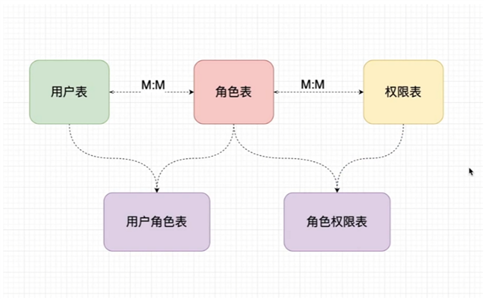
SET NAMES utf8mb4;
SET FOREIGN_KEY_CHECKS = 0;
-- ----------------------------
-- Table structure for t_pers
-- ----------------------------
DROP TABLE IF EXISTS `t_pers`;
CREATE TABLE `t_pers` (
`id` int(6) NOT NULL AUTO_INCREMENT,
`name` varchar(80) DEFAULT NULL,
`url` varchar(255) DEFAULT NULL,
PRIMARY KEY (`id`)
) ENGINE=InnoDB DEFAULT CHARSET=utf8;
-- ----------------------------
-- Table structure for t_role
-- ----------------------------
DROP TABLE IF EXISTS `t_role`;
CREATE TABLE `t_role` (
`id` int(6) NOT NULL AUTO_INCREMENT,
`name` varchar(60) DEFAULT NULL,
PRIMARY KEY (`id`)
) ENGINE=InnoDB DEFAULT CHARSET=utf8;
-- ----------------------------
-- Table structure for t_role_perms
-- ----------------------------
DROP TABLE IF EXISTS `t_role_perms`;
CREATE TABLE `t_role_perms` (
`id` int(6) NOT NULL,
`roleid` int(6) DEFAULT NULL,
`permsid` int(6) DEFAULT NULL,
PRIMARY KEY (`id`)
) ENGINE=InnoDB DEFAULT CHARSET=utf8;
-- ----------------------------
-- Table structure for t_user
-- ----------------------------
DROP TABLE IF EXISTS `t_user`;
CREATE TABLE `t_user` (
`id` int(6) NOT NULL AUTO_INCREMENT,
`username` varchar(40) DEFAULT NULL,
`password` varchar(40) DEFAULT NULL,
`salt` varchar(255) DEFAULT NULL,
PRIMARY KEY (`id`)
) ENGINE=InnoDB AUTO_INCREMENT=2 DEFAULT CHARSET=utf8;
-- ----------------------------
-- Table structure for t_user_role
-- ----------------------------
DROP TABLE IF EXISTS `t_user_role`;
CREATE TABLE `t_user_role` (
`id` int(6) NOT NULL,
`userid` int(6) DEFAULT NULL,
`roleid` int(6) DEFAULT NULL,
PRIMARY KEY (`id`)
) ENGINE=InnoDB DEFAULT CHARSET=utf8;
SET FOREIGN_KEY_CHECKS = 1;
4.创建dao方法
//根据用户名查询所有角色
User findRolesByUserName(String username);
//根据角色id查询权限集合
List<Perms> findPermsByRoleId(String id);
5.mapper实现
<resultMap id="userMap" type="User">
<id column="uid" property="id"/>
<result column="username" property="username"/>
<!--角色信息-->
<collection property="roles" javaType="list" ofType="Role">
<id column="id" property="id"/>
<result column="rname" property="name"/>
</collection>
</resultMap>
<select id="findRolesByUserName" parameterType="String" resultMap="userMap">
SELECT u.id uid,u.username,r.id,r.NAME rname
FROM t_user u
LEFT JOIN t_user_role ur
ON u.id=ur.userid
LEFT JOIN t_role r
ON ur.roleid=r.id
WHERE u.username=#{username}
</select>
<select id="findPermsByRoleId" parameterType="String" resultType="Perms">
SELECT p.id,p.NAME,p.url,r.NAME
FROM t_role r
LEFT JOIN t_role_perms rp
ON r.id=rp.roleid
LEFT JOIN t_perms p ON rp.permsid=p.id
WHERE r.id=#{id}
</select>
6.Service接口
//根据用户名查询所有角色
User findRolesByUserName(String username);
//根据角色id查询权限集合
List<Perms> findPermsByRoleId(String id);
7.Service实现
@Override
public List<Perms> findPermsByRoleId(String id) {
return userDAO.findPermsByRoleId(id);
}
@Override
public User findRolesByUserName(String username) {
return userDAO.findRolesByUserName(username);
}
8.修改自定义realm
@Override
protected AuthorizationInfo doGetAuthorizationInfo(PrincipalCollection principal) {
//获取登陆人的身份信息
String s = principal.getPrimaryPrincipal().toString();
//根据主身份信息获取角色信息和权限信息
UserService userService = (UserService) ApplicationContextUtils.getBean("userService");
User user = userService.findRolesByUserName(s);
//赋值授权角色
if(user.getRoles() != null){
SimpleAuthorizationInfo simpleAuthorizationInfo = new SimpleAuthorizationInfo();
user.getRoles().forEach(role -> {
simpleAuthorizationInfo.addRole(role.getName());
//根据角色信息返回权限信息
List<Perms> perms = userService.findPermsByRoleId(role.getId());
if(perms != null){
perms.forEach(perm->{
simpleAuthorizationInfo.addStringPermission(perm.getName());
});
}
});
return simpleAuthorizationInfo;
}
return null;
}
9.启动测试
1.Cache 作用
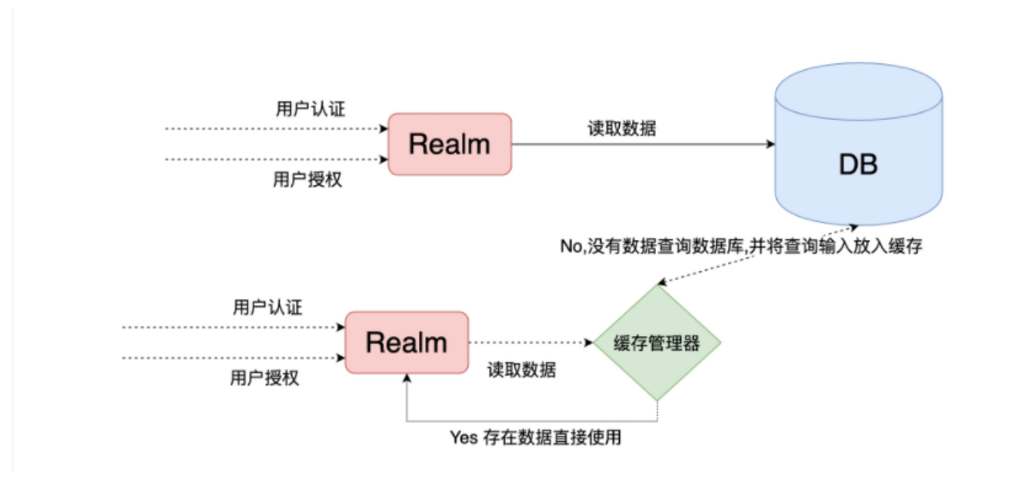
2.使用shiro中默认EhCache实现缓存
1.引入依赖
<!--引入shiro和ehcache-->
<dependency>
<groupId>org.apache.shiro</groupId>
<artifactId>shiro-ehcache</artifactId>
<version>1.5.3</version>
</dependency>
2.开启缓存
//3.创建自定义Realm
@Bean
public Realm getRealm(){
CustomerRealm customerRealm = new CustomerRealm();
//设置hashed凭证匹配器
HashedCredentialsMatcher credentialsMatcher = new HashedCredentialsMatcher();
//设置md5加密
credentialsMatcher.setHashAlgorithmName("md5");
//设置散列次数
credentialsMatcher.setHashIterations(1024);
customerRealm.setCredentialsMatcher(credentialsMatcher);
//开启缓存管理
customerRealm.setCacheManager(new EhCacheManager());
customerRealm.setCachingEnabled(true);//开启全局缓存
customerRealm.setAuthenticationCachingEnabled(true); //开启认证缓存
customerRealm.setAuthenticationCacheName("authenticationCache"); //给缓存起一个名字
customerRealm.setAuthorizationCachingEnabled(true);//开启授权缓存
customerRealm.setAuthorizationCacheName("authorizationCache");
return customerRealm;
}
3.启动刷新页面进行测试
1.引入redis依赖
<!--redis整合springboot-->
<dependency>
<groupId>org.springframework.boot</groupId>
<artifactId>spring-boot-starter-data-redis</artifactId>
</dependency>
2.配置redis连接
spring.redis.port=6379
spring.redis.host=localhost
spring.redis.database=0
3.启动redis服务
? bin ls
dump.rdb redis-check-aof redis-cli redis-server redis.conf
redis-benchmark redis-check-rdb redis-sentinel redis-trib.rb
? bin ./redis-server redis.conf
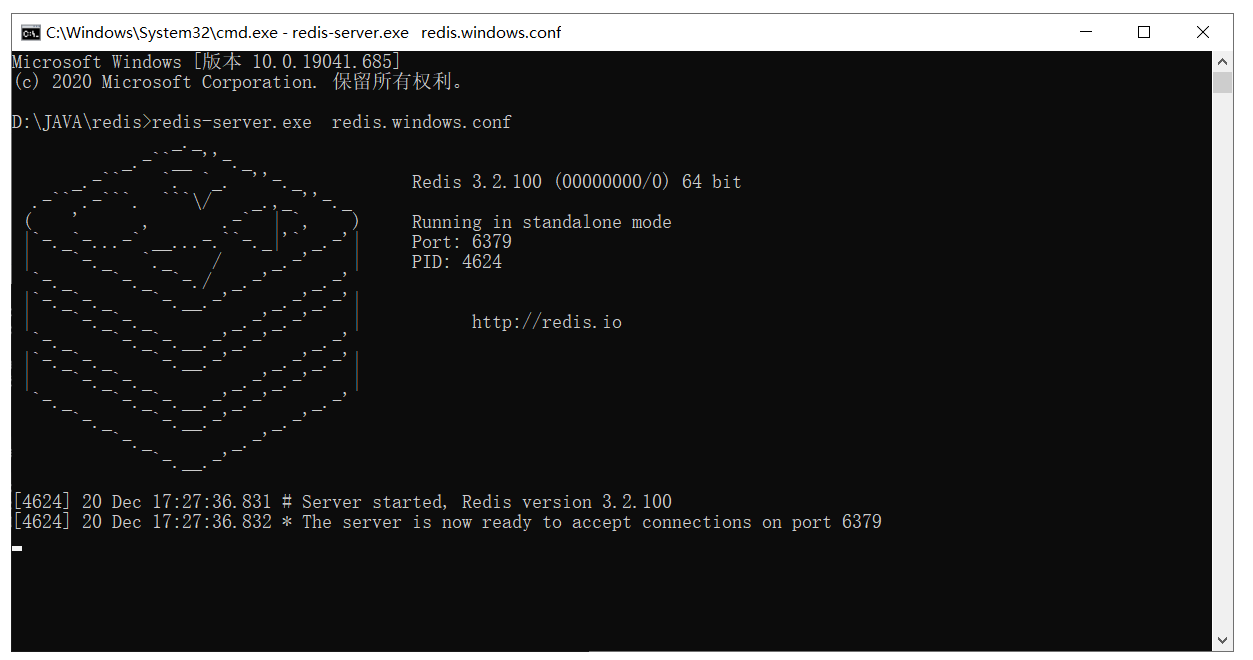
4.开发RedisCacheManager
//自定义shiro中的缓存管理器
public class RedisCacheManager implements CacheManager {
//参数:认证或者是授权的缓存的名称
@Override
public <K, V> Cache<K, V> getCache(String cacheName) throws CacheException {
return new RedisCache<K, V>();
}
}
5.开RedisCache实现
//自定义redis缓存的实现
public class RedisCache<K, V> implements Cache<K, V> {
@Override
public V get(K k) throws CacheException {
RedisTemplate redisTemplate = (RedisTemplate) ApplicationContextUtils.getBean("redisTemplate");
redisTemplate.setStringSerializer(new StringRedisSerializer());
return (V) redisTemplate.opsForValue().get(k.toString());
}
@Override
public V put(K k, V v) throws CacheException {
RedisTemplate redisTemplate = (RedisTemplate) ApplicationContextUtils.getBean("redisTemplate");
redisTemplate.setStringSerializer(new StringRedisSerializer());
redisTemplate.opsForValue().set(k.toString(),v);
return null;
}
@Override
public V remove(K k) throws CacheException {
return null;
}
@Override
public void clear() throws CacheException {
}
@Override
public int size() {
return 0;
}
@Override
public Set<K> keys() {
return null;
}
@Override
public Collection<V> values() {
return null;
}
}
6.再次启动测试,发现可以成功放入redis缓存
开发页面加入验证码
加入验证码生产的帮助类
package com.cdl.utils;
import javax.imageio.ImageIO;
import java.awt.*;
import java.awt.geom.AffineTransform;
import java.awt.image.BufferedImage;
import java.io.File;
import java.io.FileOutputStream;
import java.io.IOException;
import java.io.OutputStream;
import java.util.Arrays;
import java.util.Random;
/**
*@创建人
*@创建时间 2018/11/27 17:36
*@描述 验证码生成
*/
public class VerifyCodeUtils{
//使用到Algerian字体,系统里没有的话需要安装字体,字体只显示大写,去掉了1,0,i,o几个容易混淆的字符
public static final String VERIFY_CODES = "23456789ABCDEFGHJKLMNPQRSTUVWXYZ";
private static Random random = new Random();
/**
* 使用系统默认字符源生成验证码
* @param verifySize 验证码长度
* @return
*/
public static String generateVerifyCode(int verifySize){
return generateVerifyCode(verifySize, VERIFY_CODES);
}
/**
* 使用指定源生成验证码
* @param verifySize 验证码长度
* @param sources 验证码字符源
* @return
*/
public static String generateVerifyCode(int verifySize, String sources){
if(sources == null || sources.length() == 0){
sources = VERIFY_CODES;
}
int codesLen = sources.length();
Random rand = new Random(System.currentTimeMillis());
StringBuilder verifyCode = new StringBuilder(verifySize);
for(int i = 0; i < verifySize; i++){
verifyCode.append(sources.charAt(rand.nextInt(codesLen-1)));
}
return verifyCode.toString();
}
/**
* 生成随机验证码文件,并返回验证码值
* @param w
* @param h
* @param outputFile
* @param verifySize
* @return
* @throws IOException
*/
public static String outputVerifyImage(int w, int h, File outputFile, int verifySize) throws IOException{
String verifyCode = generateVerifyCode(verifySize);
outputImage(w, h, outputFile, verifyCode);
return verifyCode;
}
/**
* 输出随机验证码图片流,并返回验证码值
* @param w
* @param h
* @param os
* @param verifySize
* @return
* @throws IOException
*/
public static String outputVerifyImage(int w, int h, OutputStream os, int verifySize) throws IOException{
String verifyCode = generateVerifyCode(verifySize);
outputImage(w, h, os, verifyCode);
return verifyCode;
}
/**
* 生成指定验证码图像文件
* @param w
* @param h
* @param outputFile
* @param code
* @throws IOException
*/
public static void outputImage(int w, int h, File outputFile, String code) throws IOException{
if(outputFile == null){
return;
}
File dir = outputFile.getParentFile();
if(!dir.exists()){
dir.mkdirs();
}
try{
outputFile.createNewFile();
FileOutputStream fos = new FileOutputStream(outputFile);
outputImage(w, h, fos, code);
fos.close();
} catch(IOException e){
throw e;
}
}
/**
* 输出指定验证码图片流
* @param w
* @param h
* @param os
* @param code
* @throws IOException
*/
public static void outputImage(int w, int h, OutputStream os, String code) throws IOException{
int verifySize = code.length();
BufferedImage image = new BufferedImage(w, h, BufferedImage.TYPE_INT_RGB);
Random rand = new Random();
Graphics2D g2 = image.createGraphics();
g2.setRenderingHint(RenderingHints.KEY_ANTIALIASING,RenderingHints.VALUE_ANTIALIAS_ON);
Color[] colors = new Color[5];
Color[] colorSpaces = new Color[] { Color.WHITE, Color.CYAN,
Color.GRAY, Color.LIGHT_GRAY, Color.MAGENTA, Color.ORANGE,
Color.PINK, Color.YELLOW };
float[] fractions = new float[colors.length];
for(int i = 0; i < colors.length; i++){
colors[i] = colorSpaces[rand.nextInt(colorSpaces.length)];
fractions[i] = rand.nextFloat();
}
Arrays.sort(fractions);
g2.setColor(Color.GRAY);// 设置边框色
g2.fillRect(0, 0, w, h);
Color c = getRandColor(200, 250);
g2.setColor(c);// 设置背景色
g2.fillRect(0, 2, w, h-4);
//绘制干扰线
Random random = new Random();
g2.setColor(getRandColor(160, 200));// 设置线条的颜色
for (int i = 0; i < 20; i++) {
int x = random.nextInt(w - 1);
int y = random.nextInt(h - 1);
int xl = random.nextInt(6) + 1;
int yl = random.nextInt(12) + 1;
g2.drawLine(x, y, x + xl + 40, y + yl + 20);
}
// 添加噪点
float yawpRate = 0.05f;// 噪声率
int area = (int) (yawpRate * w * h);
for (int i = 0; i < area; i++) {
int x = random.nextInt(w);
int y = random.nextInt(h);
int rgb = getRandomIntColor();
image.setRGB(x, y, rgb);
}
shear(g2, w, h, c);// 使图片扭曲
g2.setColor(getRandColor(100, 160));
int fontSize = h-4;
Font font = new Font("Algerian", Font.ITALIC, fontSize);
g2.setFont(font);
char[] chars = code.toCharArray();
for(int i = 0; i < verifySize; i++){
AffineTransform affine = new AffineTransform();
affine.setToRotation(Math.PI / 4 * rand.nextDouble() * (rand.nextBoolean() ? 1 : -1), (w / verifySize) * i + fontSize/2, h/2);
g2.setTransform(affine);
g2.drawChars(chars, i, 1, ((w-10) / verifySize) * i + 5, h/2 + fontSize/2 - 10);
}
g2.dispose();
ImageIO.write(image, "jpg", os);
}
private static Color getRandColor(int fc, int bc) {
if (fc > 255)
fc = 255;
if (bc > 255)
bc = 255;
int r = fc + random.nextInt(bc - fc);
int g = fc + random.nextInt(bc - fc);
int b = fc + random.nextInt(bc - fc);
return new Color(r, g, b);
}
private static int getRandomIntColor() {
int[] rgb = getRandomRgb();
int color = 0;
for (int c : rgb) {
color = color << 8;
color = color | c;
}
return color;
}
private static int[] getRandomRgb() {
int[] rgb = new int[3];
for (int i = 0; i < 3; i++) {
rgb[i] = random.nextInt(255);
}
return rgb;
}
private static void shear(Graphics g, int w1, int h1, Color color) {
shearX(g, w1, h1, color);
shearY(g, w1, h1, color);
}
private static void shearX(Graphics g, int w1, int h1, Color color) {
int period = random.nextInt(2);
boolean borderGap = true;
int frames = 1;
int phase = random.nextInt(2);
for (int i = 0; i < h1; i++) {
double d = (double) (period >> 1)
* Math.sin((double) i / (double) period
+ (6.2831853071795862D * (double) phase)
/ (double) frames);
g.copyArea(0, i, w1, 1, (int) d, 0);
if (borderGap) {
g.setColor(color);
g.drawLine((int) d, i, 0, i);
g.drawLine((int) d + w1, i, w1, i);
}
}
}
private static void shearY(Graphics g, int w1, int h1, Color color) {
int period = random.nextInt(40) + 10; // 50;
boolean borderGap = true;
int frames = 20;
int phase = 7;
for (int i = 0; i < w1; i++) {
double d = (double) (period >> 1)
* Math.sin((double) i / (double) period
+ (6.2831853071795862D * (double) phase)
/ (double) frames);
g.copyArea(i, 0, 1, h1, 0, (int) d);
if (borderGap) {
g.setColor(color);
g.drawLine(i, (int) d, i, 0);
g.drawLine(i, (int) d + h1, i, h1);
}
}
}
public static void main(String[] args) throws IOException {
//获取验证码
String s = generateVerifyCode(4);
//将验证码放入图片中
outputImage(260,60,new File("/Users/chenyannan/Desktop/安工资料/aa.jpg"),s);
System.out.println(s);
}
}
开发控制器
@RequestMapping("getImage")
public void getImage(HttpSession session, HttpServletResponse response) throws IOException {
//生成验证码
String code = VerifyCodeUtils.generateVerifyCode(4);
//验证码放入session
session.setAttribute("code",code);
//验证码存入图片
ServletOutputStream os = response.getOutputStream();
response.setContentType("image/png");
VerifyCodeUtils.outputImage(220,60,os,code);
}
在shiro模块放行验证码请求
开发页面
<form action="${pageContext.request.contextPath}/user/login" method="post">
用户名:<input type="text" name="username" > <br/>
密码 : <input type="text" name="password"> <br>
请输入验证码: <input type="text" name="code"><img src="${pageContext.request.contextPath}/user/getImage" ><br>
<input type="submit" value="登录">
</form>
验证码生成成功
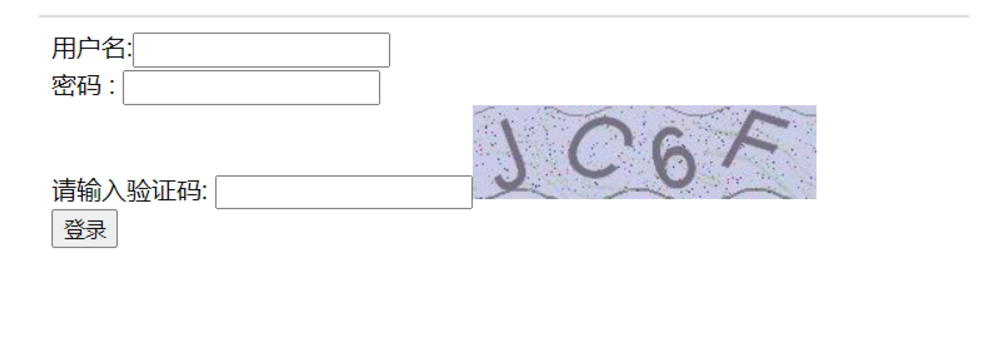
修改认证流程,在验证码校验成功之后,在进行认证
@RequestMapping("login")
public String login(String username, String password,String code,HttpSession session) {
//比较验证码
String codes = (String) session.getAttribute("code");
try {
if (codes.equalsIgnoreCase(code)){
//获取主体对象
Subject subject = SecurityUtils.getSubject();
subject.login(new UsernamePasswordToken(username, password));
return "redirect:/index.jsp";
}else{
throw new RuntimeException("验证码错误!");
}
} catch (UnknownAccountException e) {
e.printStackTrace();
System.out.println("用户名错误!");
} catch (IncorrectCredentialsException e) {
e.printStackTrace();
System.out.println("密码错误!");
}catch (Exception e){
e.printStackTrace();
System.out.println(e.getMessage());
}
return "redirect:/login.jsp";
}
# 展示身份信息
<h1><shiro:principal/></h1>
# 认证之后的信息
<shiro:authenticated>
认证之后展示内容 <br>
</shiro:authenticated>
<shiro:notAuthenticated>
没有认证在之后展示内容
</shiro:notAuthenticated>
1.引入扩展依赖
<dependency>
<groupId>com.github.theborakompanioni</groupId>
<artifactId>thymeleaf-extras-shiro</artifactId>
<version>2.0.0</version>
</dependency>
2.页面中引入命名空间
xmlns:shiro="http://www.pollix.at/thymeleaf/shiro"
<html xmlns="http://www.w3.org/1999/xhtml" xmlns:th="http://www.thymeleaf.org"
xmlns:shiro="http://www.pollix.at/thymeleaf/shiro">
3.常见权限控制标签使用
<!-- 验证当前用户是否为“访客”,即未认证(包含未记住)的用户。 -->
<p shiro:guest="">Please <a href="login.html">login</a></p>
<!-- 认证通过或已记住的用户。 -->
<p shiro:user="">
Welcome back John! Not John? Click <a href="login.html">here</a> to login.
</p>
<!-- 已认证通过的用户。不包含已记住的用户,这是与user标签的区别所在。 -->
<p shiro:authenticated="">
Hello, <span shiro:principal=""></span>, how are you today?
</p>
<a shiro:authenticated="" href="updateAccount.html">Update your contact information</a>
<!-- 输出当前用户信息,通常为登录帐号信息。 -->
<p>Hello, <shiro:principal/>, how are you today?</p>
<!-- 未认证通过用户,与authenticated标签相对应。与guest标签的区别是,该标签包含已记住用户。 -->
<p shiro:notAuthenticated="">
Please <a href="login.html">login</a> in order to update your credit card information.
</p>
<!-- 验证当前用户是否属于该角色。 -->
<a shiro:hasRole="admin" href="admin.html">Administer the system</a><!-- 拥有该角色 -->
<!-- 与hasRole标签逻辑相反,当用户不属于该角色时验证通过。 -->
<p shiro:lacksRole="developer"><!-- 没有该角色 -->
Sorry, you are not allowed to developer the system.
</p>
<!-- 验证当前用户是否属于以下所有角色。 -->
<p shiro:hasAllRoles="developer, 2"><!-- 角色与判断 -->
You are a developer and a admin.
</p>
<!-- 验证当前用户是否属于以下任意一个角色。 -->
<p shiro:hasAnyRoles="admin, vip, developer,1"><!-- 角色或判断 -->
You are a admin, vip, or developer.
</p>
<!--验证当前用户是否拥有指定权限。 -->
<a shiro:hasPermission="userInfo:add" href="createUser.html">添加用户</a><!-- 拥有权限 -->
<!-- 与hasPermission标签逻辑相反,当前用户没有制定权限时,验证通过。 -->
<p shiro:lacksPermission="userInfo:del"><!-- 没有权限 -->
Sorry, you are not allowed to delete user accounts.
</p>
<!-- 验证当前用户是否拥有以下所有角色。 -->
<p shiro:hasAllPermissions="userInfo:view, userInfo:add"><!-- 权限与判断 -->
You can see or add users.
</p>
<!-- 验证当前用户是否拥有以下任意一个权限。 -->
<p shiro:hasAnyPermissions="userInfo:view, userInfo:del"><!-- 权限或判断 -->
You can see or delete users.
</p>
<a shiro:hasPermission="pp" href="createUser.html">Create a new User</a>
4.加入shiro的方言配置
@Bean(name = "shiroDialect")
public ShiroDialect shiroDialect(){
return new ShiroDialect();
}
原文:https://www.cnblogs.com/cdlszl/p/14192540.html